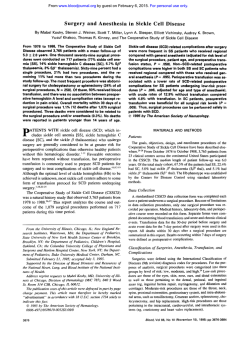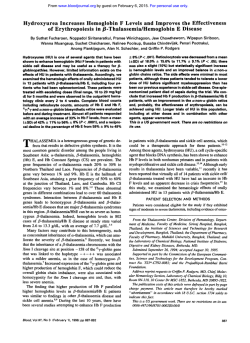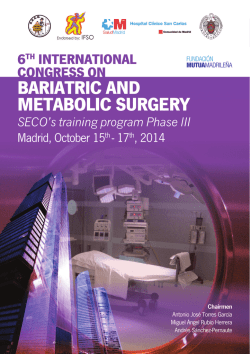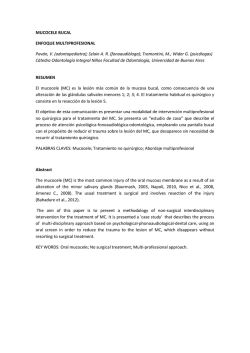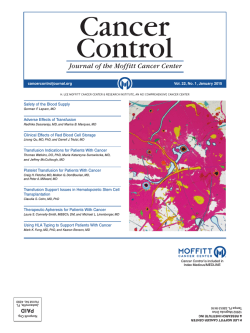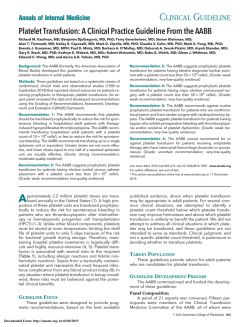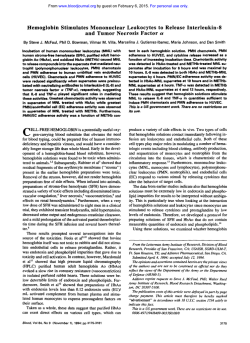
Transfusion Requirements in Surgical Oncology Patients
Transfusion Requirements in Surgical Oncology Patients A Prospective, Randomized Controlled Trial Juliano Pinheiro de Almeida, M.D., Jean-Louis Vincent, M.D., Ph.D., Filomena Regina Barbosa Gomes Galas, M.D., Ph.D., Elisangela Pinto Marinho de Almeida, M.D., Julia T. Fukushima, M.Sc., Eduardo A. Osawa, M.D., Fabricio Bergamin, M.D., Clarice Lee Park, M.D., Rosana Ely Nakamura, M.D., Silvia M. R. Fonseca, M.D., Guilherme Cutait, M.D., Joseane Inacio Alves, R.N., Mellik Bazan, P.T., Silvia Vieira, R.N., Ana C. Vieira Sandrini, L.D.N., Henrique Palomba, M.D., Ph.D., Ulysses Ribeiro, Jr., M.D., Ph.D., Alexandre Crippa, M.D., Marcos Dalloglio, M.D., Ph.D., Maria del Pilar Estevez Diz, M.D., Ph.D., Roberto Kalil Filho, M.D., Ph.D., Jose Otavio Costa Auler, Jr., M.D., Ph.D., Andrew Rhodes, M.B., B.S., Ludhmila Abrahao Hajjar, M.D., Ph.D. This article has been selected for the Anesthesiology CME Program. Learning objectives and disclosure and ordering information can be found in the CME section at the front of this issue. ABSTRACT Background: Several studies have indicated that a restrictive erythrocyte transfusion strategy is as safe as a liberal one in critically ill patients, but there is no clear evidence to support the superiority of any perioperative transfusion strategy in patients with cancer. Methods: In a randomized, controlled, parallel-group, double-blind (patients and outcome assessors) superiority trial in the intensive care unit of a tertiary oncology hospital, the authors evaluated whether a restrictive strategy of erythrocyte transfusion (transfusion when hemoglobin concentration <7 g/dl) was superior to a liberal one (transfusion when hemoglobin concentration <9 g/dl) for reducing mortality and severe clinical complications among patients having major cancer surgery. All adult patients with cancer having major abdominal surgery who required postoperative intensive care were included and randomly allocated to treatment with the liberal or the restrictive erythrocyte transfusion strategy. The primary outcome was a composite endpoint of mortality and morbidity. Results: A total of 198 patients were included as follows: 101 in the restrictive group and 97 in the liberal group. The primary composite endpoint occurred in 19.6% (95% CI, 12.9 to 28.6%) of patients in the liberal-strategy group and in 35.6% (27.0 to 45.4%) of patients in the restrictive-strategy group (P = 0.012). Compared with the restrictive strategy, the liberal transfusion strategy was associated with an absolute risk reduction for the composite outcome of 16% (3.8 to 28.2%) and a number needed to treat of 6.2 (3.5 to 26.5). Conclusion: A liberal erythrocyte transfusion strategy with a hemoglobin trigger of 9 g/dl was associated with fewer major postoperative complications in patients having major cancer surgery compared with a restrictive strategy. (Anesthesiology 2015; 122:29-38) F OR many patients with solid tumors, surgery remains the mainstay of therapy. For these patients, a complication-free operative procedure is vital to maximize the chances that oncological treatment is successful. The care of patients having abdominal oncologic surgery is challenging because of the unusually long duration of the surgical procedures, the significant fluid and blood losses that can occur, and the inherent increased operative risk related to the cancer diagnosis.1–3 Perioperative anemia occurs in 25 to 75% of patients having surgery for cancer, largely because of blood loss during long and complex surgical procedures, but poor What We Already Know about This Topic • It remains unknown whether a liberal or restrictive transfusion strategy is superior in patients having major cancer surgery What This Article Tells Us That Is New • In 198 patients randomly assigned to erythrocyte transfusions at a hemoglobin concentration of 7 or 9 g/dl • Major complications were nearly twice as common in patients managed with the restrictive approach as in those managed with the liberal approach (36 vs. 20%) • This study supports a more liberal transfusion strategy in major cancer surgery This article is featured in “This Month in Anesthesiology,” page 1A. Corresponding article on page 3. Submitted for publication January 9, 2014. Accepted for publication August 8, 2014. From the Surgical Intensive Care Unit and Department of Anesthesiology, Cancer Institute, Hospital das Clinicas da Faculdade de Medicina da Universidade de Sao Paulo, Sao Paulo, Brazil ( J.P.d.A., F.R.B.G.G., E.P.M.d.A., J.T.F., E.A.O., F.B., C.L.P., R.E.N., S.M.R.F., J.I.A., M.B., S.V., A.C.V.S., H.P., R.K.F., J.O.C.A., L.A.H.); Department of Intensive Care, Erasme Hospital, Université Libre de Bruxelles, Brussels, Belgium ( J.-L.V.); Department of Intensive Care Medicine, St. George’s Healthcare NHS Trust, London, United Kingdom (A.R.); Department of Surgery, Cancer Institute, Hospital das Clinicas da Faculdade de Medicina da Universidade de Sao Paulo, Sao Paulo, Brazil (G.C., U.R., A.C., M.D.); and Department of Oncology, Cancer Institute, Hospital das Clinicas da Faculdade de Medicina da Universidade de Sao Paulo, Sao Paulo, Brazil (M.d.P.E.D.). Copyright © 2014, the American Society of Anesthesiologists, Inc. Lippincott Williams & Wilkins. Anesthesiology 2015; 122:29-38 Anesthesiology, V 122 • No 129 January 2015 Transfusion Requirements in Surgical Oncology nutritional condition, tumor stage, cancer-related anemia, and previous chemotherapy may also contribute.4 To treat or prevent anemia, these patients often receive allogeneic erythrocyte transfusions.5–7 Recent evidence from critically ill patients has led to renewed consideration of the potential benefits and risks of erythrocyte transfusion. In patients with cancer, in particular, immunomodulation and the inflammatory consequences of transfusion may outweigh the possible advantages of improved oxygen delivery and tissue perfusion.7–9 The decision to transfuse these patients should, therefore, carefully take into account the potential risks of anemia versus known adverse effects of blood transfusion. Several previous studies have indicated that a restrictive erythrocyte transfusion strategy is as safe and effective as a liberal one in critically ill patients.10 In addition, a restrictive strategy reduces costs and results in less exposure to allogeneic blood.8 However, patients with cancer are not included in most trials investigating this issue. The aim of this study was, therefore, to compare mortality rates and severe clinical complications in high-risk abdominal oncological surgery patients managed using a restrictive or a liberal erythrocyte transfusion strategy. Our hypothesis was that a restrictive strategy of erythrocyte transfusion would be associated with improved outcomes in these patients with cancer having major surgery. Materials and Methods This study was approved by the Ethics and Research Committee of the University of Sao Paulo (Comitê de Ética em Pesquisa da Faculdade de Medicina da Universidade de São Paulo, number 002/11). Patients enrolled in the study were admitted to the intensive care unit (ICU) of a tertiary oncology university hospital in Sao Paulo, Brazil, between January 2012 and July 2012. Written informed consent was obtained from all the participants in the study. The study protocol was registered at ClinicalTrials.gov (NCT01502215). All adult patients who had a major surgical procedure for abdominal cancer and required postoperative care in the ICU because of physiological instability and had an expected ICU stay of more than 24 h were included. We excluded all patients with any of the following characteristics: age less than 18 yr, hematological malignancy, a Karnofsky score less than 50, preexisting anemia (defined as a preoperative hemoglobin concentration <9 g/dl), preexisting thrombocytopenia (defined as a platelet count <50,000/mm3), preexisting coagulopathy (defined as a prothrombin time >14.8 s) or anticoagulation therapy, active or uncontrolled bleeding, expected death within 24 h of ICU admission, end-stage renal failure requiring renal replacement therapy, pregnancy, a do-not-resuscitate order, inability to receive transfusion of blood components, or refusal to participate in the study. Anesthesiology 2015; 122:29-3830 Major surgical procedures for abdominal cancer included esophagectomy, gastrectomy, gastroduodenopancreatectomy (Whipple procedure), hepatectomy or bile duct resection, radical cystectomy, partial or total colectomy, retroperitoneal tumor resection, cytoreductive surgery with heated intraperitoneal chemotherapy, radical hysterectomy, or emergency laparotomy. Randomization and Masking All patients were assessed for eligibility at the time of ICU admission by a member of the medical staff. After signing informed consent, patients were randomized in a 1:1 ratio to one of two erythrocyte strategies: a restrictive erythrocyte transfusion strategy or a liberal erythrocyte transfusion strategy. After consent, the medical staff contacted the study randomization center to register the patient and to be told which group the patient was allocated to. To avoid loss of concealment, the group to which the patient was allocated could only be accessed after registration in the study randomization center. Allocation numbers were derived from a random number table prepared by the chief statistician and were placed in opaque envelopes and opened sequentially to determine the treatment group of the patient. The patients and the study investigators who classified outcomes and those who conducted the follow-up telephone assessments were blinded to the study-group assignments and had no access to transfusion data. Treatment Protocol The patients in the restrictive and liberal erythrocyte transfusion strategy groups received one erythrocyte unit each time their hemoglobin concentration decreased to less than 7 or 9 g/dl, respectively, during their ICU stay. Physicians were instructed to administer transfusions 1 unit at a time and to measure hemoglobin concentration after each transfused unit. In both groups, no further units were given if the goal hemoglobin concentration was obtained (7 g/dl for the restrictive strategy and 9 g/dl for the liberal strategy). Hemoglobin levels were measured in all patients at least twice a day while patients were in the ICU. After ICU discharge, hemoglobin levels were measured as clinically indicated. If the treating clinicians transfused an additional erythrocyte unit outside the protocol, it was recorded as a protocol deviation. After ICU discharge, the decision to transfuse was left to the discretion of the physician in charge of the patient clinical care. During the 30-day follow-up period, if a patient returned to the ICU for any reason, the allocated transfusion strategy was maintained. An intention-to-treat analysis was performed and considered the patients in their originally assigned groups. The erythrocytes were leukodepleted and stored in a citrate solution. The erythrocyte unit volume ranged from 250 to 350 ml, with a hematocrit of 70%. The policy of our hospital’s blood bank is to use blood that has been stored for less than 35 days. Pinheiro de Almeida et al. PERIOPERATIVE MEDICINE During the ICU stay, all other monitoring and treatment was given according to established ICU protocols. Data Collection After randomization, we recorded baseline demographic characteristics, the American Society of Anesthesiology physical status classification, and specific data on the type and status of the neoplasm and its previous treatment. The values of two scores used to assess the degree of functional impairment, the Karnofsky Performance Status scale11 (from 0 [most impaired] to 100 [least impaired]) and the Eastern Cooperative Oncology Group scale12 (from 0 [most impaired] to 5 [least impaired]), were also recorded. We also evaluated the Charlson comorbidity index, a score used to predict outcome according to the weighted presence of various comorbid conditions, which can also be adjusted by patient age (higher score, higher risk of death).13 We also collected data related to characteristics of the surgical procedure, including type of surgery, amount and types of fluids, blood transfusions, and laboratory data during the intraoperative period. During the ICU stay, all patients were assessed daily by a team of three blinded investigators and clinical and laboratory data were recorded. The lowest hemoglobin concentration and the use of erythrocyte transfusions were recorded every day. Leukocyte count, C-reactive protein, platelet count, prothrombin time and activated partial thromboplastin time, serum creatinine, troponin, creatine kinase-MB, bilirubin, arterial lactate concentration, and central venous oxygen saturation were collected daily. A Simplified Acute Physiology Score 3 was calculated using the worst value within the first 24 h of the ICU stay. An electrocardiogram was performed daily during the ICU stay. During the hospital stay, data were collected regarding hemoglobin concentrations and the use of erythrocyte transfusions. During a 30-day follow-up period, we evaluated the incidence of stroke (including transient ischemic attack), acute myocardial infarction, pulmonary embolism, congestive heart failure, cardiac arrest, septic shock, acute kidney injury (AKI), renal replacement therapy, acute respiratory distress syndrome (ARDS), mesenteric ischemia, peripheral ischemia, reoperation, and infectious complications. Acute myocardial infarction was defined as at least one of the following findings associated with clinical symptoms suggestive of myocardial ischemia: an increase or decrease in cardiac troponin I, with at least one value above the 99th percentile of the upper reference limit; electrocardiographic changes, such as new Q waves, ST-elevation, or a new left branch block; or image-based evidence of new loss of viable myocardium.14 Infectious complications included new infection, sepsis, severe sepsis, and septic shock, which was defined using standard criteria15; wound infection with positive cultures; and pneumonia, including signs of sepsis associated with a Anesthesiology 2015; 122:29-3831 new, persistent, or progressive lung infiltrate on a chest radiograph and purulent endotracheal secretions, with a Gram stain showing more than 25 neutrophils and fewer than 10 epithelial cells per field. Renal function was evaluated daily using the risk, injury, failure, loss, and end-stage classification16; patients who were classified as injury or more were defined as having AKI. Mesenteric arterial ischemia was defined as an occlusive or nonocclusive impairment of intestinal blood flow leading to bowel ischemia diagnosed by arteriography or surgery. Peripheral vascular ischemia was defined as a sudden decrease in limb perfusion characterized by an absence of arterial pulses, pale extremities, cyanosis or ischemic skin lesions, and absence of arterial blood flow on Doppler examination. ARDS was defined by the usual criteria.17 Stroke was characterized by a new focal deficit with a compatible image on computed tomography. Primary Outcome Measures The primary outcome was a composite endpoint of death from all causes or severe clinical complications within 30 days after the randomization. Severe clinical complications included major cardiovascular complications (defined as acute myocardial infarction, pulmonary embolism, congestive heart failure, cardiac arrest, acute mesenteric ischemia, stroke [including transient ischemic attack], and acute peripheral vascular ischemia), septic shock, AKI requiring renal replacement therapy, ARDS, and reoperation. Fig. 1. Study flow chart. ITT = intention to treat. Pinheiro de Almeida et al. Transfusion Requirements in Surgical Oncology Table 1. Baseline Demographic Data and Preoperative Characteristics of Patients Variables Patients, No. Age, mean (SD), yr Male (%) Body mass index, mean (SD) Hypertension (%) Diabetes (%) Dyslipidemia (%) Baseline creatinine >1.5 mg/dl (%) Tobacco use (%) COPD (%) Peripheral arterial disease (%) Cerebrovascular disease (%) Congestive heart failure (%) Arterial coronary disease (%) History of dementia (%) Age-adjusted Charlson comorbidity index American Society of Anesthesiologists risk score (%) II III IV V Nutritional risk screening (2002) score 1 2 3 4 5 6 Cachexia score 1 2 3 Hemoglobin, g/dl (SD) Serum albumin, g/dl (SD) Simplified Acute Physiology Score 3 C-reactive protein at ICU admission, mg/l Liberal Strategy Restrictive Strategy 97 64 (14) 55 (56.7) 25 (5) 51 (53.1) 20 (20.6) 10 (10.3) 11 (11.3) 42 (43.3) 5 (5.2) 1 (1.0) 2 (2.1) 3 (3.1) 6 (6.2) 1 (1.0) 6 (4–9) 101 64 (12) 55 (54.5) 25 (5) 46 (45.5) 26 (25.7) 10 (9.9) 8 (7.9) 41 (40.6) 9 (8.9) 1 (1.0) 8 (7.9) 6 (5.9) 8 (7.9) 1 (1.0) 7 (5–9) 57 (58.8) 30 (30.9) 9 (9.3) 1 (1.0) 67 (66.3) 25 (24.8) 8 (7.9) 1 (1.0) 20 (20.6) 21 (21.6) 21 (21.6) 23 (23.7) 8 (8.2) 4 (4.1) 18 (17.8) 25 (24.8) 33 (32.7) 17 (16.8) 3 (3.0) 5 (5.0) 47 (49.0) 11 (11.5) 38 (39.6) 12.4 (1.7) 2.6 (0.6) 34 (29–45) 79 (45–116) 52 (51.5) 5 (5.0) 44 (43.6) 12.6 (1.8) 2.6 (0.5) 37 (31–46) 73 (49–117) COPD = chronic obstructive pulmonary disease; ICU = intensive care unit. Secondary Outcome Measures Secondary outcomes included the 30-day incidence of infection, development of AKI, need and duration of mechanical ventilation, duration of vasopressor therapy, ICU readmission rate, ICU and hospital lengths of stay, and 60-day mortality. Other secondary outcomes included need for erythrocyte transfusion and the number of units transfused. Statistical Analysis This was a superiority trial, and we predicted a 40% incidence of the primary outcome based on a previous study showing rates of 40 to 60%.18 A minimum enrollment of 164 patients was required to provide 80% statistical power to detect a difference of 20% with a two-sided α = 0.05. We added 20% to the sample size to compensate for subject attrition, yielding a final requirement for 197 patients. Anesthesiology 2015; 122:29-3832 We compared the baseline characteristics, follow-up measures, and clinical outcomes on an intention-to-treat basis according to randomized study-group assignment. Continuous variables were compared using a t test or the Mann–Whitney U test, and categorical variables were compared using Pearson chi-square test, Fisher exact test, or a likelihood ratio test. We compared hemoglobin levels during the ICU stay between groups using a mixed-design ANOVA model because many patients died or were discharged from the ICU at different times. The model was constructed using the lowest daily average hemoglobin concentrations during the ICU stay. Results are expressed as means with SDs or medians with interquartile ranges (IQRs). We calculated unadjusted 30-day Kaplan–Meier survival estimates, dividing patients according to the transfusion strategy and the number of transfused erythrocyte units. A two-sided P value less than 0.05 was considered to be statistically significant. The Pinheiro de Almeida et al. PERIOPERATIVE MEDICINE Table 2. Characteristics Related to the Underlying Malignancies of Patients and Types of Surgical Procedure Variables (%) Liberal Strategy (N = 97) Type of tumor Upper gastrointestinal Lower gastrointestinal Pancreas Liver and biliary tract Urogenital Other Extent of cancer Localized Metastatic Karnofsky performance status ECOG performance status 0 1 2 3 4 Chemotherapy in the 4 wk before ICU admission Type of procedure Esophagectomy Gastrectomy Gastroduodenopancreatectomy Liver resection Biliary duct resection Colectomy Peritonectomy with intraperitoneal chemotherapy Abdominoperineal rectal amputation Resection of retroperitoneal tumor Emergency laparotomy Pelvic exenteration Radical cystectomy Radical hysterectomy Duration of surgery (min) Type of anesthesia General Spinal Spinal + general Intraoperative fluid (l) Restrictive Strategy (N = 101) 20 (20.6) 33 (34.0) 6 (6.2) 1 (1.0) 27 (27.8) 11 (11.3) 20 (19.8) 45 (44.6) 5 (5.0) 3 (3.0) 22 (21.8) 7 (6.9) 65 (67.0) 32 (33.0) 90 (80–100) 62 (61.4) 39 (38.6) 90 (80–100) 38 (40.0) 41 (43.2) 7 (7.4) 7 (7.4) 2 (2.1) 6 (6.2) 45 (45.0) 41 (41.0) 10 (10.0) 4 (4.0) 0 (0) 8 (7.9) 5 (5.2) 12 (12.4) 3 (3.1) 9 (9.3) 2 (2.1) 23 (23.7) 2 (2.1) 2 (2.1) 3 (3.1) 9 (9.3) 1 (1.0) 17 (17.5) 9 (9.3) 355 (250–493) 7 (6.9) 8 (7.9) 7 (6.9) 13 (12.9) 2 (2.0) 18 (17.8) 7 (6.9) 7 (6.9) 2 (2.0) 13 (12.9) 1 (1.0) 9 (8.9) 7 (6.9) 323 (188–476) 33 (34.0) 1 (1.0) 63 (64.9) 4.5 (3.5–6.0) 32 (31.7) 2 (2.0) 67 (66.3) 4.5 (3.5–6.5) ECOG = Eastern Cooperative Oncology Group; ICU = intensive care unit. statistical analyses were performed using SPSS version 18.0 (SPSS Inc., Chicago, IL). Results Study Population A total of 1,521 patients were screened for eligibility and 234 met the inclusion criteria (fig. 1). After exclusions for medical reasons or lack of consent, 198 patients were enrolled in the study; of whom, 97 were randomized to the liberal group and 101 to the restrictive group. All patients completed the study and were followed up for outcome criteria. Baseline characteristics were well balanced between the study groups (table 1). The majority of the patients had a good performance status and localized disease and had an elective surgical procedure for gastrointestinal cancer (table 2). Anesthesiology 2015; 122:29-3833 Primary Outcome The primary composite endpoint at 30-days—all-cause mortality, cardiovascular complication, ARDS, AKI requiring renal replacement therapy, septic shock, or reoperation— occurred in 19 patients (19.6%) in the liberal-strategy group and in 36 patients (35.6%) in the restrictive-strategy group (P = 0.012). This represents an absolute risk reduction for the liberal strategy of 16% (95% CI, 3.8 to 28.2) and a number needed to treat of 6.2 (95% CI, 3.5 to 26.5) to avoid the composite outcome. Secondary Outcomes In total, 31 patients (15.7%) died during the 30-day follow-up. The 30-day mortality rate was lower in the liberalstrategy group than in the restrictive group (8 [8.2%] vs. 23 Pinheiro de Almeida et al. Transfusion Requirements in Surgical Oncology Fig. 2. Kaplan–Meier curves showing the probability of 30day survival in patients randomized to a restrictive strategy of erythrocyte transfusion (transfusion when hemoglobin concentration <7 g/dl) and those randomized to a liberal strategy (transfusion when hemoglobin concentration <9 g/dl). The P value was calculated with the use of the log-rank test. [22.8%]; P = 0.005; fig. 2). At 60 days, we also observed a lower mortality rate in the liberal group compared with the restrictive group (11 [11.3%] vs. 24 [23.8%]; P = 0.022). At 30 days, the most frequent cause of death was septic shock and multisystem organ failure (24 patients), followed by noninfectious circulatory shock (3 patients), cancer-related complication (3 patients), and respiratory failure (1 patient). At 30 days, the number of patients with major cardiovascular events was lower in the liberal than in the restrictive group (5 [5.2%] vs. 14 [13.9%]; P = 0.038). There were no differences between groups in the incidence of each major cardiovascular complication separately (table 3). There was a higher incidence of intraabdominal infection in the restrictive group than the liberal group (15 [14.9%] vs. 5 [5.2%]; P = 0.024), but no differences in the incidence of other infections. There was no difference in the incidence of septic shock in the restrictive group compared with the liberal group (13.4 vs. 21.8%; P = 0.122). There were no statistically significant differences between the liberal and restrictive-strategy groups in the occurrence of ARDS, incidence of AKI or dialysis, requirement and duration of mechanical ventilation, incidence of reoperation, use of vasopressors, and lengths of time in ICU or hospital (table 3). Hemoglobin Concentrations and Transfusion Hemoglobin concentrations (mean, 11.0 g/dl [±1.6] vs. 11.2 g/dl [±1.8]; P = 0.46) and the number of patients transfused before randomization were similar in both groups (table 4). The average hemoglobin concentration before transfusion was higher in the liberal-strategy group than in the restrictive-strategy group (7.9 g/dl [±0.5] vs. 6.8 g/dl [±0.5]; P < 0.001; table 4). Hemoglobin concentrations were statistically significantly higher in the liberal-strategy group than in the restrictive-strategy group during the ICU stay (P < 0.001; fig. 3). Anesthesiology 2015; 122:29-3834 More patients received an erythrocyte transfusion in the liberal-strategy group than in the restrictive-strategy group during the ICU stay (42.3 vs. 20.8%; P = 0.005). Among transfused patients, the liberal-strategy group received a median of 2 erythrocyte units (IQR, 1 to 3), whereas the restrictive-strategy group received a median of 1 unit (IQR, 1 to 3; P = 0.17). Most transfusions were given after the third day of the ICU stay. During the hospital stay, more patients in the liberal-strategy group received an erythrocyte transfusion than did patients in the restrictive-strategy group (48.5 vs. 32.7%; P = 0.024). The average hemoglobin concentration before transfusion in the regular ward was similar between groups (7.5 g/dl [±0.6] vs. 7.5 g/dl [±0.9]; P = 0.99) There was no difference in the age of erythrocyte units between the liberal- and the restrictive-strategy groups (median, 10 days [IQR, 12 to 15] vs. 13 days [IQR, 9 to 16]; P = 0.74; table 4). Attending physicians could administer erythrocyte transfusions outside the rules of the protocol if they considered the patient status to be life threatening, as in hemorrhagic or other forms of circulatory shock; such an event was considered a protocol deviation. There were 13 cases of protocol deviation in the liberal group; in all cases, patients did not receive erythrocyte transfusion when the hemoglobin concentration was less than 9 g/dl. In the restrictive group, there were seven cases of protocol deviation; in all cases, patients received erythrocyte transfusion when the hemoglobin concentration was greater than 7 g/dl. Discussion In this trial involving 198 critically ill patients who were admitted to a surgical ICU after major surgery for abdominal cancer, a blood transfusion strategy using a hemoglobin trigger of 9.0 g/dl was superior to a transfusion strategy using a trigger of 7.0 g/dl in terms of the primary outcome (30-day mortality or severe clinical complications). The restrictive erythrocyte transfusion strategy was also associated with an increased rate of severe complications, including intraabdominal infections, cardiovascular complications, and 60-day mortality, compared with the liberal group. Our study enrolled patients with active cancer who had a high risk of postoperative complications. The aim was to assess the “trade-off” between the complications of postoperative anemia and the benefits of blood transfusion in this high-risk population using two different blood transfusion strategies and a composite endpoint of cardiovascular events, severe surgical complications, infection, organ failure, and death. In two previous randomized controlled trials in highrisk surgical patients, one concerning cardiac surgery (the Transfusion Requirements After Cardiac Surgery study)19 and the other major orthopedic surgery (the Transfusion Trigger Trial for Functional Outcomes in Cardiovascular Pinheiro de Almeida et al. PERIOPERATIVE MEDICINE Table 3. Outcome Measures Variable, % (95% CI) Primary outcome Death or severe complication at 30 d Secondary outcomes Mortality from all causes at 30 d Acute respiratory distress syndrome Septic shock Acute kidney injury Renal replacement therapy Cardiovascular complications Myocardial infarction Stroke or transient ischemic attack Mesenteric ischemia Peripheral arterial ischemia Unexpected cardiac arrest Congestive heart failure Pulmonary embolism Reoperation New infection Source of infection Abdomen Lung Urinary tract Wound Mediastinum Blood stream Unidentified Need for mechanical ventilation during ICU stay Duration of mechanical ventilation, median IQR, d Need for vasopressor during ICU stay Duration of vasopressor, median IQR, d ICU readmission ICU length of stay, median IQR, d Hospital length of stay, median IQR, d 60-d mortality from all causes Liberal Strategy (N = 97) Restrictive Strategy (N = 101) P Value 19.6 (12.9–28.6) 35.6 (27.0–45.4) 0.012 8.2 (4.2–15.4) 0 (0–3.8) 13.4 (8.0–21.6) 45.4 (35.8–55.3) 2.1 (0.6–7.2) 5.2 (2.2–11.5) 0 (0–3.8) 0 (0–3.8) 0 (0–3.8) 1.0 (0.2–5.6) 1.0 (0.2–5.6) 2.1 (0.6–7.2) 1.0 (0.2–5.6) 10.3 (5.7–18.0) 21.6 (14.6–30.8) 22.8 (15.7–31.9) 2.0 (0.5–6.9) 21.8 (14.9–30.8) 43.6 (34.3–53.3) 3.0 (1.0–8.4) 13.9 (8.4–21.9) 1.0 (0.2–5.4) 3.0 (1.0–8.4) 1.0 (2.0–5.4) 2.0 (0.5–6.9) 4.0 (1.6–9.7) 5.0 (2.1–11.1) 1.0 (2.0–5.4) 16.8 (10.8–25.3) 30.7 (22.5–40.3) 0.005 0.498 0.122 0.799 1.00 0.038 1.00 0.247 1.00 1.00 0.369 0.445 1.00 0.181 0.148 5.2 (2.2–11.5) 7.2 (3.5–14.2) 3.1 (1.1–8.7) 4.1 (1.6–10.1) 1.0 (0.2–5.6) 4.1 (1.6–10.1) 1.0 (0.2–5.6) 30.9 (22.6–40.7) 14.9 (9.2–23.1) 7.9 (4.1–14.9) 3.0 (1.0–8.4) 3.0 (1.0–8.4) 2.0 (0.5–6.9) 3.0 (1.0–8.4) 0 (0–3.7) 39.6 (30.1–49.4) 0.024 0.851 1.00 0.717 1.00 0.717 0.490 0.202 2 (1–3) 2 (1–2) 58.8 (48.8–68.0) 2 (2–4) 15.5 (9.6–24.0) 4 (3–7) 13 (10–20) 11.3 (6.5–19.2) 0.803 56.4 (46.7–65.7) 2 (1–4) 17.8 (11.6–26.4) 4 (3–8) 14 (10–22) 23.8 (16.5–32.9) 0.740 0.476 0.656 0.758 0.686 0.022 ICU = intensive care unit; IQR = interquartile range. Patients Undergoing Surgical Hip Fracture Repair study),20 no benefit in terms of reduced severe postoperative complications or mortality was demonstrated when comparing a liberal transfusion strategy with a restrictive strategy. We formulated our hypothesis based on these studies that demonstrated that a restrictive strategy of blood transfusion was safe in surgical patients.19,20 However, our results showed the opposite effect: We found that patients in the restrictive-strategy group were more likely to achieve the primary endpoint particularly in relation to cardiovascular events and death. There are several differences between these studies and the current study that may, in part, explain the different results. First, the Transfusion Requirements After Cardiac Surgery study19 enrolled only patients who were having elective cardiac surgery, whereas we included both elective and emergency surgical patients. Second, in the Transfusion Requirements After Cardiac Surgery study, a higher trigger was used to define the restrictive group (a Anesthesiology 2015; 122:29-3835 hematocrit of 24% and a hemoglobin level of approximately 8.0 g/dl) compared with the hemoglobin threshold of 7.0 g/dl used in the current study. In the Functional Outcomes in Cardiovascular Patients Undergoing Surgical Hip Fracture Repair study,20 the hemoglobin threshold was again 8.0 g/dl or symptoms of anemia; as a result of this less restrictive strategy, 41% of the patients in the Functional Outcomes in Cardiovascular Patients Undergoing Surgical Hip Fracture Repair–restrictive group received erythrocyte transfusions compared with 21% in our study. Furthermore, only 3% (approximately 60) of the patients in the Functional Outcomes in Cardiovascular Patients Undergoing Surgical Hip Fracture Repair study were transferred to the ICU. Conversely, all of the participants in our study were critically ill. Other factors may also help explain some of the differences in our results compared with those of previous studies. First, we used leukodepleted blood in all transfused patients. The Pinheiro de Almeida et al. Transfusion Requirements in Surgical Oncology Table 4. Hemoglobin Concentrations and Erythrocyte Transfusions Variable Hemoglobin concentration at ICU admission, g/dl (SD) Hemoglobin concentration before transfusion during ICU stay, g/dl (SD) Hemoglobin concentration before transfusion in regular wards, g/dl (SD) Transfusion before randomization 0 unit—total No. (%) 1 or more units—total No. (%) Total No. of units Transfusion during ICU stay 0 unit—total No. (%) 1 unit—total No. (%) 2 units—total No. (%) 3 units—total No. (%) ≥4 units—total No. (%) Transfusion during hospital stay 0 units—total No. (%) 1 or more units—total No. (%) Total no. of units Protocol deviation (%) Age of transfused erythrocytes (d) Liberal Strategy (N = 97) Restrictive Strategy (N = 101) 11.0 (1.6) 7.9 (0.5) 7.5 (0.6) 11.2 (1.8) 6.8 (0.5) 7.5 (0.9) 70 (72.2) 27 (27.8) 2 (1–3) 76 (75.2) 25 (24.8) 1 (1–2) 56 (57.7) 14 (14.4) 8 (8.2) 13 (13.4) 6 (6.2) 80 (79.2) 12 (11.9) 3 (3) 2 (2) 4 (4) 50 (51.5) 47 (48.5) 134 13 (13.4) 10 (12–15) 68 (67.3) 33 (32.7) 88 7 (6.9) 13 (9–16) P Value 0.458 <0.001 0.99 0.622 0.105 0.005 0.024 0.131 0.743 ICU = intensive care unit. leukocyte component of transfused blood has been associated with development of acute lung injury, immunosuppressive effects, postoperative infection, and systemic inflammatory response syndrome. Second, our erythrocyte units had a shorter storage time compared with previous studies.20,21 Older erythrocytes have increased adherence to the endothelium and reduced capacity for tissue oxygen transport because of the higher affinity for oxygen when compared with younger erythrocytes, thus potentially limiting the benefits of blood transfusion. Fig. 3. The mean lowest hemoglobin concentration per day during the first 14 days in patients randomized to a restrictive strategy of erythrocyte transfusion (transfusion when hemoglobin concentration <7 g/dl) and those randomized to a liberal strategy (transfusion when hemoglobin concentration <9 g/ dl). The P value was calculated using a mixed-model ANOVA to verify differences in hemoglobin concentrations over time between groups. Anesthesiology 2015; 122:29-3836 Another possible explanation for the different finding is that patients with cancer receiving restrictive transfusions may be more susceptible to altered oxygen delivery and impaired tissue oxygenation during the postoperative period, leading to higher rates of complications and death. Jhanji et al.22 reported that patients having major abdominal surgery who had impaired microvascular flow after surgery experienced a higher rate of postoperative complications than did patients with normal microvascular flow (measured with sublingual capillaroscopy). Abnormalities in microvascular flow can occur when hemoglobin levels decrease less than 8.0 g/dl. In a study of patients with trauma with an average hemoglobin of 7.5 g/dl and impaired capillary perfusion, Weinberg et al.23 demonstrated that erythrocyte transfusion improved microvascular flow. However, no changes were observed after blood transfusions in patients with normal capillary perfusion. Several small trials have also demonstrated that strategies based on maximizing oxygen delivery after major surgery may reduce postoperative complications.18,24–28 A relationship between anemia and postoperative mortality has been described in other studies.29–31 Carson et al.29 reported that pre- and postoperative anemia was independently associated with 30-day mortality, particularly in patients with cardiovascular disease. In a propensity score– matched retrospective study, Wu et al.31 showed that erythrocyte transfusion in patients with hematocrit levels less than 24% (approximately equal to hemoglobin concentrations of 8.0 g/dl) was associated with reduced 30-day postoperative mortality in elderly patients having major, noncardiac surgery. Similar findings were reported by Sakr et al.21 who Pinheiro de Almeida et al. PERIOPERATIVE MEDICINE conducted a large prospective study of 5,925 patients in a surgical ICU and reported that anemia (hemoglobin concentration <9.0 g/dl) was common and was associated with higher morbidity and mortality. In a further analysis, after propensity score matching and adjusting for possible confounders, higher hemoglobin concentrations and the receipt of a blood transfusion were independently associated with a lower risk of hospital mortality.21 The main cause of mortality in our study was multiple organ failure as a result of septic shock, particularly in patients who developed surgical complications and intraabdominal infection. Although there is no evidence from randomized clinical trials that a restrictive strategy increases mortality in patients with severe sepsis or septic shock, recent studies have suggested a potential benefit of blood transfusion in this population. Park et al.32 reported in a propensity score– matched cohort that blood transfusion was independently associated with a lower risk of 7-day, 28-day, and in-hospital mortality in patients with severe sepsis and septic shock. Similar findings were also reported by Sakr et al.21 in surgical patients. In their study, blood transfusion was independently associated with a lower risk of in-hospital death, especially in patients aged from 66 to 80 yr, in patients admitted to the ICU after noncardiovascular surgery, in patients with higher severity scores, and in patients with severe sepsis.21 Our study has limitations inherent to a single-center study. We performed the study in a tertiary university hospital for patients with cancer within the public health system. Our results may, therefore, reflect the characteristics of our center and generalization of our findings to other centers may be limited. However, we observed a 30-day mortality rate of 15.5%, similar to that reported in a recent South American multicenter cohort of patients having surgery for cancer who were admitted to the ICU.33 In a recent large European survey of patients having noncardiac surgery for whom ICU admission was required, 14% died before hospital discharge.3 Another limitation of our study is the lack of long-term follow-up of patients, and thus we could not address any potential negative effects of transfusion on cancer recurrence. Conclusion In this controlled, randomized trial of patients admitted to the ICU after major surgery for abdominal cancer, a liberal erythrocyte transfusion strategy using a hemoglobin threshold of 9.0 g/dl was superior to a restrictive strategy with a hemoglobin threshold of 7.0 g/dl. Our findings are highly relevant because a restrictive erythrocyte transfusion policy has been advocated for surgical patients with cancer because of the potential association between erythrocyte transfusion and cancer recurrence. The association of a restrictive postoperative blood transfusion strategy with poorer short-term outcomes, even from a single-center study, should alert physicians to the possibility that a restrictive strategy, based on a hemoglobin concentration of 7.0 g/dl, may not be as safe as previously perceived. Anesthesiology 2015; 122:29-3837 Acknowledgments Support was provided solely from institutional and/or departmental sources. Competing Interests The authors declare no competing interests. Correspondence Address correspondence to Dr. Vincent: Erasme University Hospital, Route de Lennik 808, B-1070 Brussels, Belgium. [email protected]. This article may be accessed for personal use at no charge through the Journal Web site, www. anesthesiology.org. References 1.Law S, Wong KH, Kwok KF, Chu KM, Wong J: Predictive factors for postoperative pulmonary complications and mortality after esophagectomy for cancer. Ann Surg 2004; 240:791–800 2. Masoomi H, Kang CY, Chen A, Mills S, Dolich MO, Carmichael JC, Stamos MJ: Predictive factors of in-hospital mortality in colon and rectal surgery. J Am Coll Surg 2012; 215:255–61 3. Pearse RM, Moreno RP, Bauer P, Pelosi P, Metnitz P, Spies C, Vallet B, Vincent JL, Hoeft A, Rhodes A; European Surgical Outcomes Study (EuSOS) Group for the Trials Groups of the European Society of Intensive Care Medicine and the European Society of Anaesthesiology: Mortality after surgery in Europe: A 7 day cohort study. Lancet 2012; 380:1059–65 4. Weber RS, Jabbour N, Martin RC II: Anemia and transfusions in patients undergoing surgery for cancer. Ann Surg Oncol 2008; 15:34–45 5. Acheson AG, Brookes MJ, Spahn DR: Effects of allogeneic red blood cell transfusions on clinical outcomes in patients undergoing colorectal cancer surgery: A systematic review and meta-analysis. Ann Surg 2012; 256:235–44 6.Dicato M, Plawny L, Diederich M: Anemia in cancer. Ann Oncol 2010; 21(suppl 7):vii167–72 7. Koch M, Antolovic D, Reissfelder C, Rahbari NN, Holoch J, Michalski I, Sweiti H, Ulrich A, Büchler MW, Weitz J: Leucocyte-depleted blood transfusion is an independent predictor of surgical morbidity in patients undergoing elective colon cancer surgery-a single-center analysis of 531 patients. Ann Surg Oncol 2011; 18:1404–11 8. Amato A, Pescatori M: Perioperative blood transfusions for the recurrence of colorectal cancer. Cochrane Database Syst Rev 2006;CD005033 9. Vamvakas EC, Blajchman MA: Deleterious clinical effects of transfusion-associated immunomodulation: Fact or fiction? Blood 2001; 97:1180–95 10.Hébert PC, Wells G, Blajchman MA, Marshall J, Martin C, Pagliarello G, Tweeddale M, Schweitzer I, Yetisir E: A multicenter, randomized, controlled clinical trial of transfusion requirements in critical care. Transfusion Requirements in Critical Care Investigators, Canadian Critical Care Trials Group. N Engl J Med 1999; 340:409–17 11. Schag CC, Heinrich RL, Ganz PA: Karnofsky performance status revisited: Reliability, validity, and guidelines. J Clin Oncol 1984; 2:187–93 12.Oken MM, Creech RH, Tormey DC, Horton J, Davis TE, McFadden ET, Carbone PP: Toxicity and response criteria of the Eastern Cooperative Oncology Group. Am J Clin Oncol 1982; 5:649–55 13. Charlson ME, Pompei P, Ales KL, MacKenzie CR: A new method of classifying prognostic comorbidity in longitudinal studies: Development and validation. J Chronic Dis 1987; 40:373–83 Pinheiro de Almeida et al. Transfusion Requirements in Surgical Oncology 14. Thygesen K, Alpert JS, White HD; Joint ESC/ACCF/AHA/WHF Task Force for the Redefinition of Myocardial Infarction: Universal definition of myocardial infarction. J Am Coll Cardiol 2007; 50:2173–95 15. Levy MM, Fink MP, Marshall JC, Abraham E, Angus D, Cook D, Cohen J, Opal SM, Vincent JL, Ramsay G; SCCM/ESICM/ACCP/ ATS/SIS: 2001 SCCM/ESICM/ACCP/ATS/SIS International Sepsis Definitions Conference. Crit Care Med 2003; 31:1250–6 16. Bellomo R, Ronco C, Kellum JA, Mehta RL, Palevsky P; Acute Dialysis Quality Initiative workgroup: Acute renal failure— Definition, outcome measures, animal models, fluid therapy and information technology needs: The Second International Consensus Conference of the Acute Dialysis Quality Initiative (ADQI) Group. Crit Care 2004; 8:R204–12 17. Bernard GR, Artigas A, Brigham KL, Carlet J, Falke K, Hudson L, Lamy M, Legall JR, Morris A, Spragg R: The AmericanEuropean Consensus Conference on ARDS. Definitions, mechanisms, relevant outcomes, and clinical trial coordination. Am J Respir Crit Care Med 1994; 149(3 Pt 1):818–24 18.Pearse R, Dawson D, Fawcett J, Rhodes A, Grounds RM, Bennett ED: Early goal-directed therapy after major surgery reduces complications and duration of hospital stay. A randomised, controlled trial [ISRCTN38797445]. Crit Care 2005; 9:R687–93 19. Hajjar LA, Vincent JL, Galas FR, Nakamura RE, Silva CM, Santos MH, Fukushima J, Kalil Filho R, Sierra DB, Lopes NH, Mauad T, Roquim AC, Sundin MR, Leão WC, Almeida JP, Pomerantzeff PM, Dallan LO, Jatene FB, Stolf NA, Auler JO Jr: Transfusion Requirements After Cardiac Surgery: The TRACS randomized controlled trial. JAMA 2010; 304:1559–67 20. Carson JL, Terrin ML, Noveck H, Sanders DW, Chaitman BR, Rhoads GG, Nemo G, Dragert K, Beaupre L, Hildebrand K, Macaulay W, Lewis C, Cook DR, Dobbin G, Zakriya KJ, Apple FS, Horney RA, Magaziner J; FOCUS Investigators: Liberal or restrictive transfusion in high-risk patients after hip surgery. N Engl J Med 2011; 365:2453–62 21. Sakr Y, Lobo S, Knuepfer S, Esser E, Bauer M, Settmacher U, Barz D, Reinhart K: Anemia and blood transfusion in a surgical intensive care unit. Crit Care 2010; 14:R92 22. Jhanji S, Vivian-Smith A, Lucena-Amaro S, Watson D, Hinds CJ, Pearse RM: Haemodynamic optimisation improves tissue microvascular flow and oxygenation after major surgery: A randomised controlled trial. Crit Care 2010; 14:R151 23. Weinberg JA, MacLennan PA, Vandromme-Cusick MJ, Angotti JM, Magnotti LJ, Kerby JD, Rue LW III, Barnum SR, Patel RP: Microvascular response to red blood cell transfusion in trauma patients. Shock 2012; 37:276–81 Anesthesiology 2015; 122:29-3838 24.Flancbaum L, Ziegler DW, Choban PS: Preoperative intensive care unit admission and hemodynamic monitoring in patients scheduled for major elective noncardiac surgery: A retrospective review of 95 patients. J Cardiothorac Vasc Anesth 1998; 12:3–9 25. Lobo SM, Salgado PF, Castillo VG, Borim AA, Polachini CA, Palchetti JC, Brienzi SL, de Oliveira GG: Effects of maximizing oxygen delivery on morbidity and mortality in high-risk surgical patients. Crit Care Med 2000; 28:3396–404 26.Pearse R, Dawson D, Fawcett J, Rhodes A, Grounds RM, Bennett ED: Changes in central venous saturation after major surgery, and association with outcome. Crit Care 2005; 9:R694–9 27. Pearse RM, Belsey JD, Cole JN, Bennett ED: Effect of dopexamine infusion on mortality following major surgery: Individual patient data meta-regression analysis of published clinical trials. Crit Care Med 2008; 36:1323–9 28. Sakr Y, Chierego M, Piagnerelli M, Verdant C, Dubois MJ, Koch M, Creteur J, Gullo A, Vincent JL, De Backer D: Microvascular response to red blood cell transfusion in patients with severe sepsis. Crit Care Med 2007; 35:1639–44 29.Carson JL, Duff A, Poses RM, Berlin JA, Spence RK, Trout R, Noveck H, Strom BL: Effect of anaemia and cardiovascular disease on surgical mortality and morbidity. Lancet 1996; 348:1055–60 30. Carson JL, Noveck H, Berlin JA, Gould SA: Mortality and morbidity in patients with very low postoperative Hb levels who decline blood transfusion. Transfusion 2002; 42:812–8 31. Wu WC, Schifftner TL, Henderson WG, Eaton CB, Poses RM, Uttley G, Sharma SC, Vezeridis M, Khuri SF, Friedmann PD: Preoperative hematocrit levels and postoperative outcomes in older patients undergoing noncardiac surgery. JAMA 2007; 297:2481–8 32. Park DW, Chun BC, Kwon SS, Yoon YK, Choi WS, Sohn JW, Peck KR, Kim YS, Choi YH, Choi JY, Kim SI, Eom JS, Kim HY, Cheong HJ, Song YG, Choi HJ, Kim JM, Kim MJ: Red blood cell transfusions are associated with lower mortality in patients with severe sepsis and septic shock: A propensitymatched analysis. Crit Care Med 2012; 40:3140–5 33.Soares M, Caruso P, Silva E, Teles JM, Lobo SM, Friedman G, Dal Pizzol F, Mello PV, Bozza FA, Silva UV, Torelly AP, Knibel MF, Rezende E, Netto JJ, Piras C, Castro A, Ferreira BS, Réa-Neto A, Olmedo PB, Salluh JI; Brazilian Research in Intensive Care Network (BRICNet): Characteristics and outcomes of patients with cancer requiring admission to intensive care units: A prospective multicenter study. Crit Care Med 2010; 38:9–15 Pinheiro de Almeida et al.
© Copyright 2024
